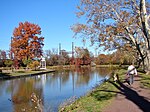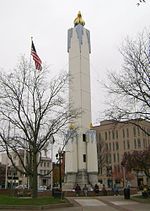Becker Farm Railroad

The Becker Farm Railroad (also known as the Centerville and Southwestern Railroad) was located on the Becker dairy farm in Roseland, New Jersey, US. This 2-inch scale, 9+7⁄16 in (240 mm) gauge miniature railway, which featured a live steam locomotive, small-scale diesel locomotives, and small-scale passenger cars, was the brainchild of Eugene Becker. The railroad dated back to 1938, with the first revenue trips taking place ten years later. The railroad was modeled after the Delaware, Lackawanna and Western Railroad's Sussex Branch, on which Becker had a creamery at Straders, New Jersey, near the end of the line at Branchville, NJ (about 35 miles (56 km) away from Roseland as the crow flies). After World War II, the C&S RR was extended to Peachtree Jct., approximately one mile from Centerville Station. Peachtree Jct. was not initially built as a continuous track, but rather as a wye track (Y-shaped configuration) that allowed the engine to be moved from the front to the rear of the train for the return trip. By 1949, the track had been extended to the edge of the Becker property in a 2,000-foot (610 m) loop that eliminated the need for using the wye track. A total of 7,000 feet (2,100 m) of track had been laid.
Excerpt from the Wikipedia article Becker Farm Railroad (License: CC BY-SA 3.0, Authors, Images).Becker Farm Railroad
Cross Street,
Geographical coordinates (GPS) Address Website Nearby Places Show on map
Geographical coordinates (GPS)
| Latitude | Longitude |
|---|---|
| N 40.68759 ° | E -75.19421 ° |
Address
Phillipsburg Railroad Historians Museum
Cross Street
08865
New Jersey, United States
Open on Google Maps










